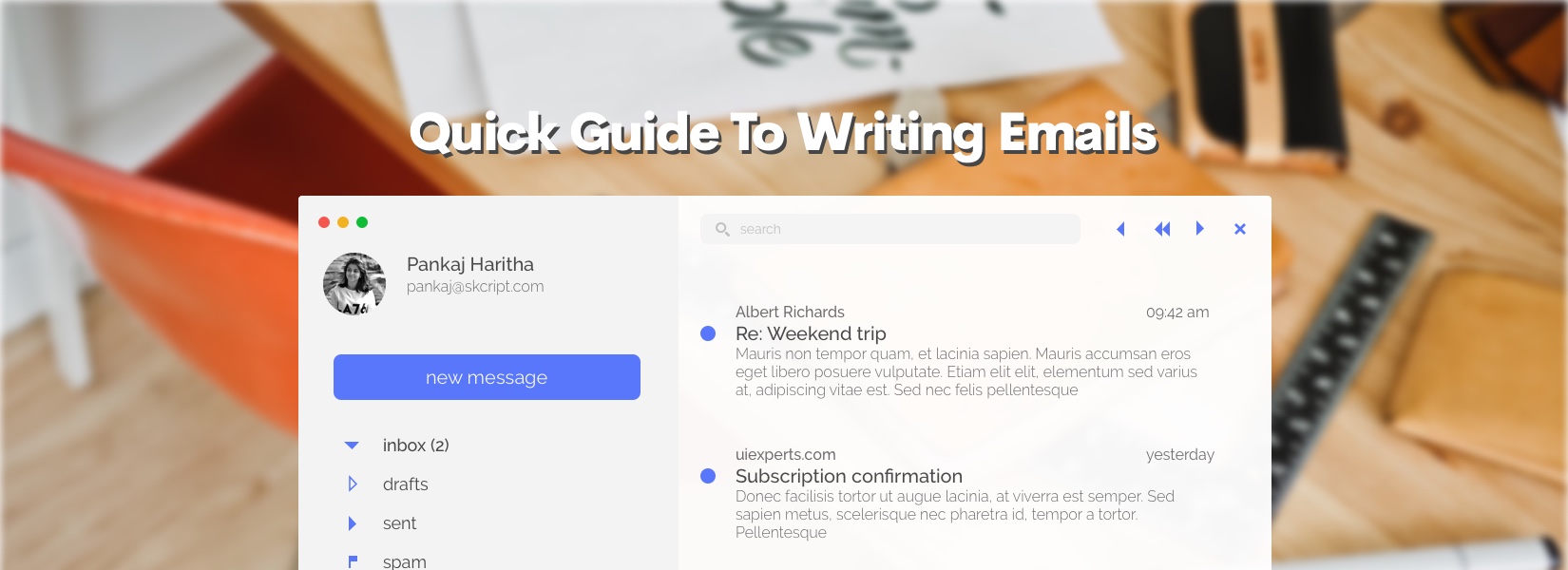Writing emails is something that has been taught to us in high school, yet, most of us don’t seem to get the hang of it. Probably because the formats used in school are of no use in the real world. When it comes to professional emails, there are few things to bear in mind. Let’s get to it!
Addressing The Recipient
While addressing the recipient, it is very important to spell the name correctly. I know it might sound silly, like it should be something that’s understood but you wouldn’t believe the number of emails I receive completely abusing my name. Thing is, if you spell a name correctly, no one notices but it if you don’t - it will definitely give an impression that you are careless.
Another important point to remember when addressing is what term you use. If you are unsure about using a Ms or Mrs (in some cases even using a Mr. or Ms. can be confusing!) - don’t use any of it, just precede the name with a greeting, like ‘Hi’ or ‘Hello’!
This has happened to me a lot of times, given that I am the owner of a name that is used mostly by men in the North. (But it’s ironical, given its a Sanskrit word for the flower, Lotus. Come on people!). I, for one, love my name but when people address me as ‘sir’ or act all surprised when they come to know that I am a girl, it’s quite annoying. There have been cases where even after my colleague introducing me with the pronoun ‘she’, the responder will completely ignore it and address me ‘sir’! (This is probably a tip in itself - read all your emails diligently!)
Formatting
Emails are used a lot of times for recording a conversation that took place, like MOMs, release reports or agendas. Since these are long form content, it’s easy for the reader to loose track.
To avoid that make sure to break paragraphs! After breaking leave a one-line space. It organises information for the reader into smaller chunks, making it easier to consume. Something else I always do is to highlight keywords. I know this sounds highschool-ish, but the reality is people scan through long emails, they don’t read them. Highlighting text using bold, italics, underline or using a different color will aid the reader in quickly asserting what is important.
Signature
Your signature is very important. Too much information can ruin a signature and too little can be useless. Having a four-line signature is the sweet-spot.
Include your name, designation, organization name (hyperlinked to the official website) followed by the pitch of your organization (you can skip this part). That’s it!
No one wants all your social media links, the awards you’ve received, your dog’s picture or the dreaded postal address! That’s what websites are for - to provide information about your organization. But if your signature is like a mini-website to your organization, trust me it doesn’t get any visits.
Subject
If your email has to be opened, then you have to be good at writing subject liners.
The subject of an email has to convey what the email is going to talk about in less than 8 words. Most emails go straight to trash because it doesn’t catch the eye of the beholder.
Another cognitive bias technique you can use is to stick to a format in the subject line. This allows your receiver to sense what the body of the email would be without putting in too much effort.
For an MOM type of email I use the format,
Name of Meeting - Number (if you keep track of report number)- Name of Project - Date of Meeting
This works perfectly fine for MOMs, release reports and status reports.
For emails that provide information, use the core information in the subject. For example,
Kanban View Queries - Allt
The automatically conveys that the email will have content talking about the queries focused on the kanban view of Allt.
P.S: Notice I didn’t use the irritating ‘reg’. Just don’t. Trust me.
CC/BCC
Have you ever been spammed with emails? Well, that is because the sender was not worried about looping unwanted people!
Unfortunately this sometimes extends to professional emails as well. There is nothing more irritating than adding people to the loop who don’t have any relevance. Have only the core team involved and filter people using the subject of the email. Loop only the designers if the email is about design related subject or the developers if its a technical email.
And always - ALWAYS - hit ‘Reply All’. If you’ve been put into a conversation with other people, it means the sender wants the other people in loop too!
Apart from these major pointers, there are these few minor checks you will have to do before hitting send. Double check your attachments. If it’s too large, upload it to a file service (like Dropbox/Drive) and just include the link. And always check your grammar and spelling! Oh yeah, send the email to the right person. You have no idea how many times I’ve had this almost happen to me.
If you keep all this in mind, writing emails should get so much more fun!
Up next
A Design Language System Example Part 3 #DLS Skcript
/svr/quick-guide-to-writing-emails/
/svrmedia/heroes/f/writing-emails.jpg
Skcript
/svr/quick-guide-to-writing-emails/
/svrmedia/heroes/f/writing-emails.jpg
